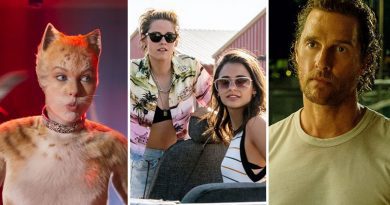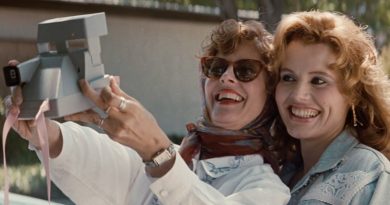Die Hard 2 at 30: Bigger But Not Better
The familiar phrase “go big or go home” certainly rings true for most Hollywood big-budget sequels during the 90s. All they have to do is take the winning formula from the successful original, give it a tweak and raise the stakes with a bigger budget at the director’s disposal.
Die Hard 2 happens to be one of them, the sequel to the 1988 genre-defining action classic that famously turned Bruce Willis of TV’s Moonlighting fame into an overnight sensation. The sequel basically takes the first movie’s single-location formula by switching from the confines of Nakatomi Plaza to a larger-scale Dulles International Airport.
It even repeats some of the other storytelling beats, namely putting Bruce Willis’ John McClane in the wrong place at the wrong time situation all over again and of course, saving his beloved wife Holly (Bonnie Bedelia) for the second time in a row. Only this time, it’s not from the terrorists who have taken her hostage seen in the first film. But more like preventing his wife on the mid-air plane from losing fuel since a team of mercenaries led by Colonel Stuart (William Sadler) taking over the airport control system.

Renny Harlin, whose previous credits were primarily low-budget horror films including Prison (1987) and A Nightmare on Elm Street 4: The Dream Master (1988), made his first big-budget Hollywood film in Die Hard 2. It was no doubt a huge undertaking and a bold choice at the time. John McTiernan, who last directed the first Die Hard went on to make The Hunt for Red October instead, which was released four months prior.
Like McTiernan, Harlin proves to be an accomplished visual stylist and he’s handling the larger-scale production like a seasoned pro. He knows his way around with the action sequences, most of which are staged with enough visual flair and excitement. The kind that makes them a must-see on the big screen.
But as massively entertaining as Die Hard 2 manages to deliver in spades, Harlin also turns up a few notches too high for its own good. Seemingly believing that a sequel needs to be doubled for whatever the formula has done successfully the first time around, there are times that Harlin looks as if he’s making a James Bond movie.
While the first Die Hard did contain several scenes that required us to suspend our disbelief (the famous roof jump comes to mind), the sequel takes the same sacrifice of logic a tad further. In Die Hard, McClane is depicted as a wisecracking New York cop who relies heavily on his street smarts to overcome difficult scenarios. Don’t get me wrong, he still delivers the same devil-may-care personality that we come to enjoy watching him in the first place.
The only biggest difference between his character in the first movie and the sequel is how he has morphed into a James Bond-like action figure. Some cases in point: He knows to ride a snowmobile like a pro and has no problem strapping the seatbelts on the plane seat and even successfully ejects himself out of the cockpit right before the plane blows into smithereens. A lucky f***, indeed as one of the characters puts it. The latter scene is particularly absurd and glaringly over-the-top even at the time of the release. I remember seeing that for the first time on VHS and yes, it looks unintentionally laughable. The effect itself looks both fake and dated even if viewed back in the 90s.
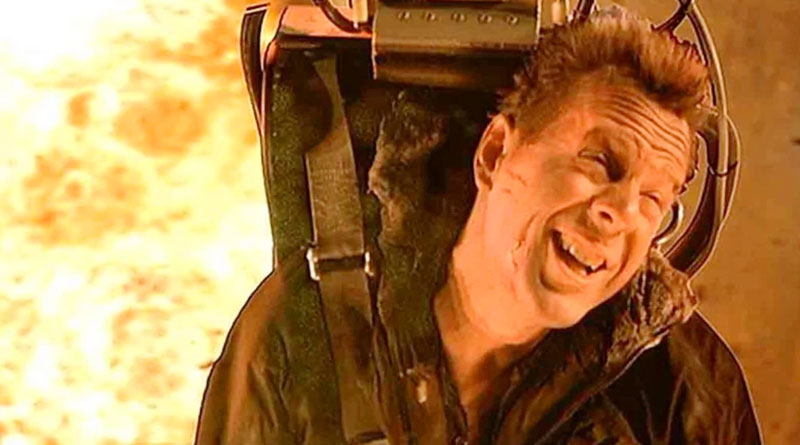
If that’s not enough, he even wouldn’t mind go as far as risking his life by jumping from the helicopter and landed on the wing of a moving plane. Something that James Bond would routinely do as part of his job. And yet, for all the boundaries-pushing action moments (with the exception of that ejection seat sequence, of course), it’s hard to deny the sheer amount of entertainment that made Die Hard 2 a worthy sequel. Sure, the sequel doesn’t exactly recapture the same magic of the first film and Harlin is no McTiernan when comes to the overall direction. But how often you get to watch a big-budget Hollywood sequel that doesn’t feel like a tired rehash? (here’s looking at you, Another 48 Hrs.)
The plot, again written by Die Hard scribe Steven E. de Souza alongside first-timer Doug Richardson (who also contributed Bad Boys and Money Train five years later), retains the same “one man (John McClane)-against-the-terrorists” angle but with a bigger-scale setting mentioned earlier in the paragraph above. All the aforementioned suspension of disbelief aside, the story doesn’t waste time with unnecessary fillers. Clocking a little over two hours long, Die Hard 2 rarely flags with a reasonably swift pace as well as memorable character interactions and classic one-liners (e.g. “Hey Carmine, let me ask you something. What sets off the metal detectors first, the lead in your a** or the shit in your brains? and “Yippie-kai-yay, motherf*****”). Like the first film, Die Hard 2 even includes a sleight-of-hand twist that explained some of the characters’ true motivations.
Apart from its technical triumph, Die Hard 2 also features some of the memorable acting performances, beginning with the then-bankable star Bruce Willis’ iconic role of John McClane. He’s fun to watch regardless of the way he cracks jokes or (mostly) single-handedly taking out the bad guys with guns and fistfights. At one point, he also improvised by killing his enemy brutally with an… icicle. I guess Harlin’s background as a horror director earlier in his career does come in handy after all.
Then, there’s William Sadler who plays the lead of the mercenaries Colonel Stuart. He’s got that perfectly sinister look in his face, making him one of the best villains in the Die Hard franchise, even though he’s no match with the late Alan Rickman’s performance as Hans Gruber in the first film and Jeremy Irons’ Simon Gruber in Die Hard with a Vengeance (1995). Besides, who could forget the scene where he shows no remorse by causing a plane crashes onto the ground that killed everyone on board?
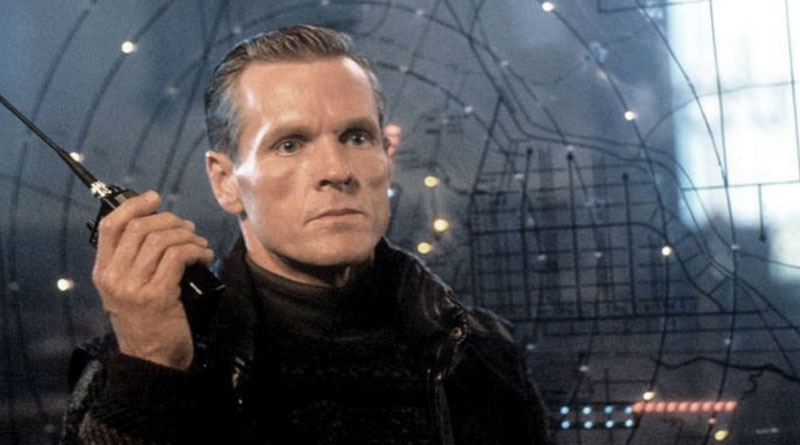
The sequel also reunites some of the first film’s characters, with Bonnie Bedelia is largely confined in the mid-air plane. But she manages to make good use of her otherwise limited performance, particularly with her sardonic interaction with the returning arrogant reporter Richard Thornburg (William Atherton). Reginald VelJohnson’s Sergeant Al Powell, who had a bigger supporting role in the first film, is sadly reduced to a cameo in this sequel. If there’s any consolation, at least it’s not a worthless cameo appearance just for the sake of it. The now-retired actor Dennis Franz, best known for his role of Detective Andy Sipowicz in the then-groundbreaking TV series NYPD Blue during the 90s, made quite an impression in his solid supporting turn as the no-nonsense airport cop Captain Carmine Lorenzo.
Interestingly enough, Die Hard 2 also featured two then-unknown actors Robert Patrick (who appeared as one of the mercenaries disguised as a worker in the airport’s Annex Skywalk) and John Leguizamo in a blink-and-you’ll-miss-him cameo role as another mercenary. Both of them are nobodies and relative newcomers at the time before went on to appear in more significant roles, with Robert Patrick famously became a household name as T-1000 in Terminator 2: Judgment Day (1991).
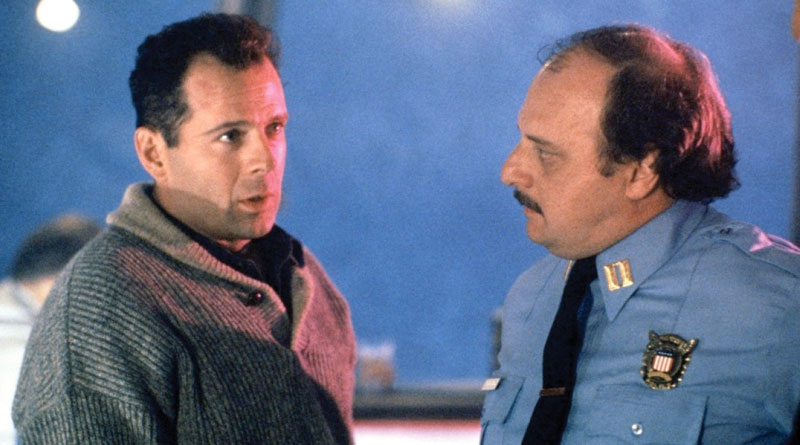
Having recently re-watched Die Hard 2, I can’t believe it has been 30 years since it made its debut back in July 1990. Viewing it by today’s standard and with some of the exceptions regarding the out-of-touch dialogues (“Honey, it’s the ’90s, remember? Microchips, microwaves, faxes, air phones”), the sequel still brings the kind of palpable excitement that relies heavily on practical effects than CG. It made me missed how Bruce Willis used to be one of my favourite Hollywood action stars at the time before he becomes a pale shadow of his former self these days.
The same also goes with Renny Harlin, who used to be one of the must-see Hollywood directors in the action genre. His huge success in Die Hard 2, where it made over US$240 million worldwide — mind you, it was a massive amount back then — helps to boost his career throughout the 90s with Cliffhanger (1993) and to certain extents, Cutthroat Island (1995) and The Long Kiss Goodnight (1996).



